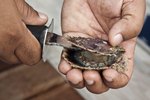
Compared with mammals -- or even vertebrates in general -- the corals include a diverse variety of animals in terms of shape and size. The main division between corals is the split between the hard corals and soft corals. While both kinds have some overlap in aquarium care, they have a few differences in their husbandry.
Hard Corals

Hard corals have hard, calcium-based skeletons. Most hard corals -- also called stony corals -- consist of numerous single polyps living together in colonies. A single polyp consists of a sea-anemonelike organism that secretes the calcium-based structure of the colony's skeleton. If you look very closely at the polyp, all hard corals' polyps have rings of six smooth tentacles. Hard corals provide the majority of structure on coral reefs, with their dead skeletons becoming the anchors for other corals, including both hard and soft coral.
Soft Corals

Soft corals' chief difference from hard corals is structural. While hard corals secrete calcium-based skeletons, soft corals do not. Instead, soft corals contain structures within their tissues called spiracles that support their bodies. Additionally, soft corals have eight fuzzy tentacles for feeding. Aquarium hobbyists often consider zoanthids to be soft corals. While a biologist would consider zoanthids a type of sea anemone, for aquarium purposes, their care is identical to true soft corals.
Caring for Hard Corals

In terms of aquarium care, hard corals are among the hardest organisms to keep happy and thriving. In order to thrive in aquariums, hard corals need powerful lighting and supplemental minerals. Hard corals need about 5 watts of light per gallon of aquarium water. Since hard corals absorb calcium and other minerals to make their skeletons, you need to provide extra calcium. You can provide this with liquid supplements, calcium-rich substrates and specialized equipment like calcium reactors. You should always position hard corals at least 6 inches from each other, since many species unfurl sweeper tentacles to sting nearby encroaching corals.
Caring for Soft Corals

Soft corals require specialized care, but less than hard corals do. Still, both types of corals include a huge range of species, so exceptions exist in the form of difficult soft corals and easy hard corals. Soft corals still need calcium supplementation but less than hard corals, since soft corals need only enough to produce and maintain their spiracles. Most species of soft corals also need 5 watts of light per gallon. Keep in mind that many species of soft coral, particularly star polyps, button polyps and mushroom corals may reproduce rapidly, and spread across hard surfaces in the aquarium.
References
Photo Credits
-
Comstock/Comstock/Getty Images




